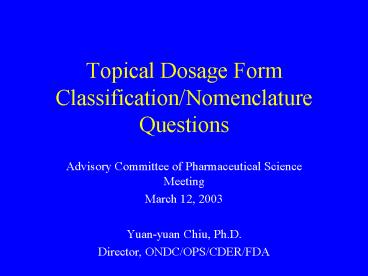Topical Dosage Form Classification/Nomenclature Questions - PowerPoint PPT Presentation
1 / 9
Title:
Topical Dosage Form Classification/Nomenclature Questions
Description:
Questions. Advisory Committee of Pharmaceutical Science Meeting. March 12, 2003 ... Question #1 ... Question #2 ... – PowerPoint PPT presentation
Number of Views:97
Avg rating:3.0/5.0
Title: Topical Dosage Form Classification/Nomenclature Questions
1
Topical Dosage FormClassification/NomenclatureQu
estions
- Advisory Committee of Pharmaceutical Science
Meeting - March 12, 2003
- Yuan-yuan Chiu, Ph.D.
- Director, ONDC/OPS/CDER/FDA
2
Question 1
- The appearance and feel of a topical dosage form
is part of the proposed definitions. In
conversation with practitioners and evaluation of
the literature, words such as greasy, non-greasy
and cooling are often used when describing these
dosage forms. Is there any value in including
these attributes in the definitions?
3
Question 2
- Laboratory work found viscosity to be the most
discriminating property that separated lotions
from creams. In addition, most literature
sources describe lotions as liquids and creams as
semi-solids. In the proposed definitions, lotion
is distinguished from cream based on
pourablility which we found in the lab to be a
viscosity less than 30,000 cp using the
Brookfield viscometer at 25oC and 5rpm. Is this
reasonable?
4
Question 3
- Laboratory work found LOD (Loss on Drying) to be
a discriminating property that separated
ointments from creams. In addition, a review of
the current submissions to ONDC and OGD found
that ointments had large percentages of
hydrocarbons or PEGs in their bases. In the
proposed definitions, ointment is distinguished
from cream based on the proportions of volatiles
(lt20 LOD) and composition (hydrocarbons or PEGs
gt50). Is this reasonable?
5
Question 4
- The distinction between hydrophilic and
lipophilic creams is made based on the
composition of the continuous phase. Is there
any value in including these two types of creams
in the definitions?
6
Question 5a
- Gel is distinguished from cream based on the
presence of sufficient quantities of a gelling
agent to form three-dimensional, cross-linked
matrix. Is this reasonable? Should sufficient
quantities be defined? Which literature sources
should be used as references?
7
Question 5b
- Some currently marketed gels contain an
emulsifier that gives the dosage form an opaque
appearance. Should the presence of an emulsifier
in a formulation preclude a dosage form from
being classified as a gel? Should it then be
considered a cream instead of gel?
8
Question 5c
- What is the most appropriate analytical technique
that can be used to identify the three
dimensional structure of a gel?
9
Question 6
- Is the overall approach taken in the proposed
definitions appropriate?































